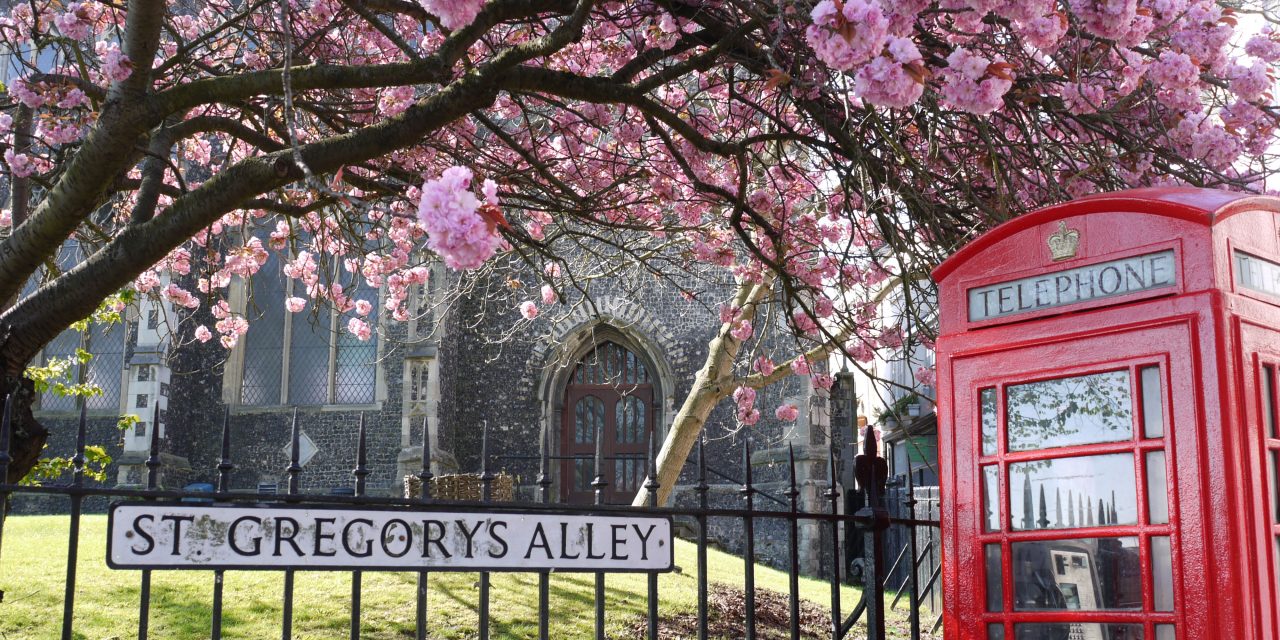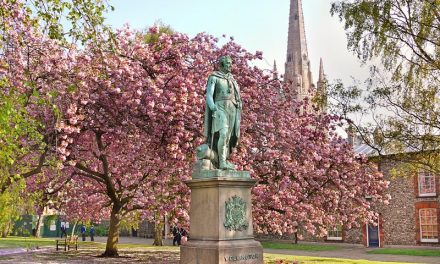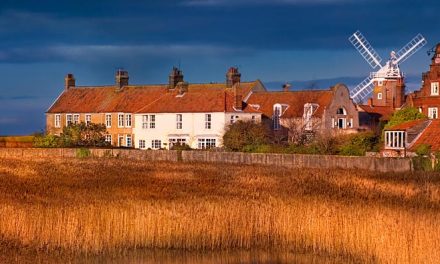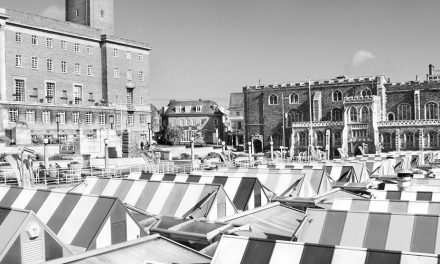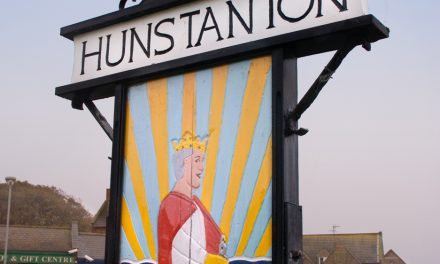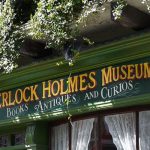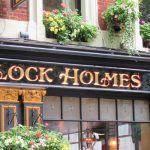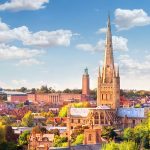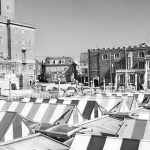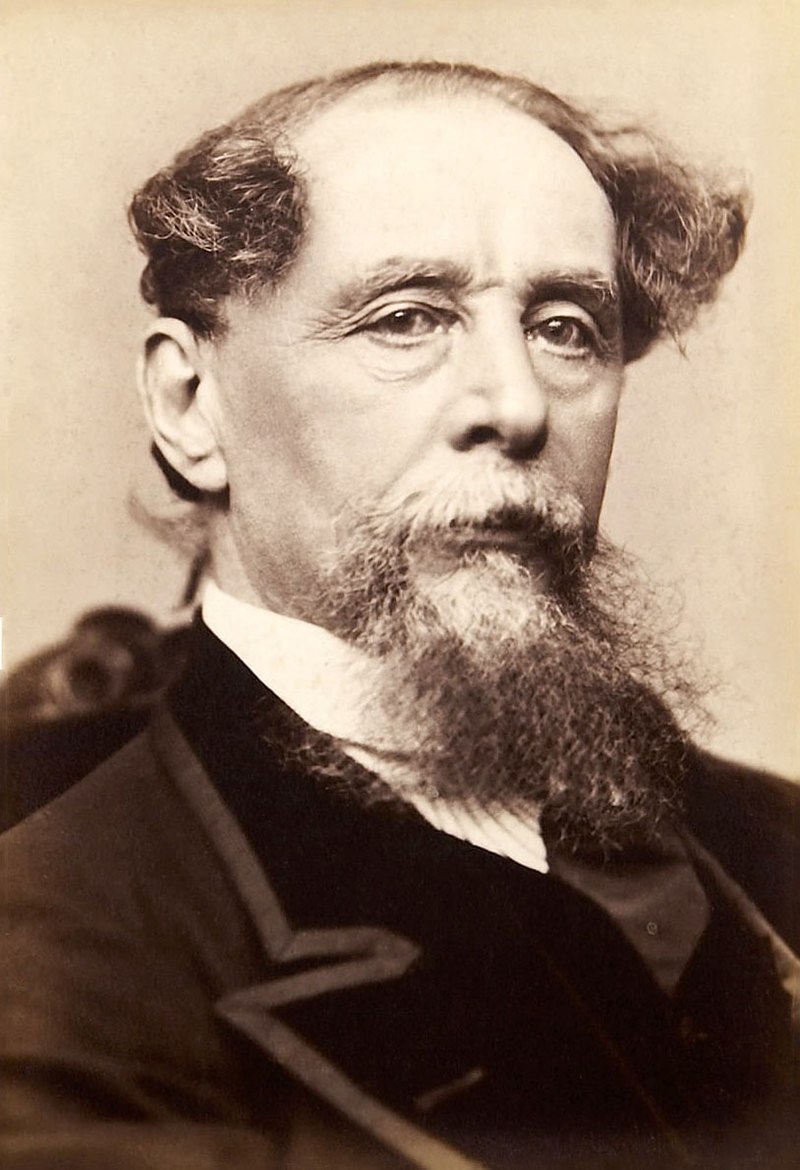A STROLL AROUND THE FAMOUS NORWICH LANES A walk through St Benedicts Street, Cow Hill, Upper St Giles Street, Pottergate and the Lanes, taking in Maddermarket Theatre and Strangers’ Hall.
To start this fascinating walk you need to ‘drop down’ from the town centre to St Benedicts Street – if the sun is up and frying has started, just stand behind the old Guildhall and follow the delicious smell of chips emanating from the Grosvenor Fish Bar, then cross the green, nip down the alley beside the church and you are at the starting point. Cross the road and a few yards down you will come to St Lawrence steps on your right hand side.
Resisting the temptation to go down the steps and heading straight on, a slow stroll down St Benedicts Street will reveal four churches and an eclectic array of shops and cafes. Here you can buy a trombone, a wedding dress, a rare book, an easel and paints, a foccacia sandwich, a craftsman-made pine chest, some gem stones to bring peace to your house, a t-shirt that, for some reason says ‘POW-ZAT!’, tinned vegetables from Poland, a scale model of Goldfinger’s Rolls Royce, a house plant from Peru, and a pair of skis for your next visit to St Moritz. You can buy French, Greek, Italian, or Indian food as well as English Pub Grub. You can convert your unwanted presents and household items into cash. You can chill out in a sports bar with a giant plasma screen or linger over a pint of Guinness in a traditional pub such as the ‘Ten Bells’. And all of this is within a few hundred yards of the starting point. Notice the Norwich Arts Centre on your right as you walk down the street. Here, again, is an imaginative use of an old church. There is live music, interactive exhibitions, storytelling, poetry nights, live music, photographic courses and all sorts of things taking place in the Centre. It also contains a peaceful café.
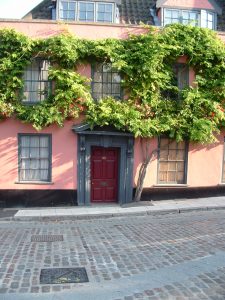
Almost opposite the Arts Centre, turn left into Ten Bell Lane where the walk starts to get quite steep. On the corner with Pottergate, you will pass the Micawber Tavern, named after the famous character in Dickens’ ‘David Copperfield’ who always believed that ‘something will turn up’. Walk straight ahead and along Cow Hill towards the imposing church of St Giles on the Hill. At the top of the hill turn right into Upper St Giles Street. This is a pretty street where you can dine in some first class restaurants – advance booking recommended. It also houses some of the city’s most notable delicatessens and patisseries where everything from home-made organic scotch eggs to take-away crème brulees are available. You will pass some shops selling reclaimed architectural treasures and antiques, so here is the place to come for a Victorian marble fire surround or an original oil painting from the Regency period.
The street comes to a sudden end as the Grapes Hill dual carriageway cuts rudely across it. A fine view of the Roman Catholic Cathedral is in front of you which makes for a fine visit as does the Victorian Garden beside it (I am amazed sometimes to find that Norwich residents who have lived here all their lives don’t know this magical little kingdom exists). For now though, cross the street and start to walk back along Upper Giles Street. At the top of the road is a plaque commemorating that fine English actor, Sir John Mills, who went to school here. Apparently, he hated it. Sir John provides another link to Charles Dickens in the public mind because one of his most celebrated roles was Pip in ‘Great Expectations’. Charles Dickens loved Norfolk. Some of his greatest writing features the county – notably Great Yarmouth which stars in ‘David Copperfield’, Dickens’ favourite of all his novels. His attitude to it must have been a little ambivalent, however, as, in a private letter to his agent in 1849, he referred to the city as ‘a spongy and soppy place’. In ‘The Pickwick Papers’, Mr Pickwick and Sam Weller, the characters that propelled him to international fame at the age of 25, also had some memorable adventures in Norfolk. Famously, the hilarious description of an election at Eatanswill in the book is a critical but affectionate comment on Norwich. Dickens writes that ‘ …the Eatanswill people, like the people of many other small towns, considered themselves of the utmost and most mighty importance…’. He might well have been standing in St Giles Street as he said this. It is also documented that he came here to witness one of the last public hangings and that he was appalled at what he saw. Thereafter, he campaigned against this barbaric practice, particularly the ‘party atmosphere’ of the proceedings. He was a hero in his own lifetime and is credited with helping to change the people’s attitude to public punishments.
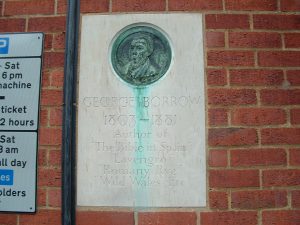
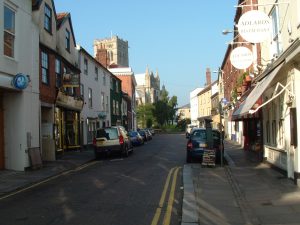
Walk back down the street and past the impressive Church of St Giles on the Hill, the gardens of which, in Spring and Summer are a riot of colour in a classic English way with giant specimens of hollyhocks and foxgloves almost hiding the lower parts of the church walls. A wonderful lilac wisteria winds around the wall beside the road. Turn sharp left down Willow Lane: just where it meets Cow Hill, on your right, is a plaque commemorating George Borrow – the man who coined the term ‘Norwich – A Fine City’ – who lived here.
Turn right into Pottergate. This ancient street has been the centre of many trades. The name derives from the pottery industry that existed prior to the 13th century. Shoe manufacturing peaked in the 18th and 19th centuries. An eye infirmary established here eventually became incorporated with the Norfolk and Norwich Hospital. The famous, and widely idolized opera singer, Jenny Lind, established a Hospital for Sick Children here in mid- Victorian times. More recently, it became the home of Norwich Job Centre and some English Language Schools – a modern-day Norwich industry. George Borrow pops up all over the city and here is no exception as he lived in Pottergate for a period.
Ahead is St Gregory’s Alley. A pleasant grass area with refurbished seating, it is an oasis for many folk who sit down, on the grass, new seating or low walls in front of St Gregory’s Pottergate, to have a bite. There is a delicatessen, a fish and chip shop, some sandwich bars and a juice bar all within a few yards. St Gregory’s Pottergate is now a craft centre with a café and ‘The Birdcage’ Pub borders the green. You are now at the very centre of Norwich Lanes and perhaps you would like to browse around the Lanes to the north, south, east and west of this spot, and continue the walk when you get back. Many compare this to the more famous ‘Brighton Lanes’. The many small entrepreneurs who trade around here are the perfect antidote to ‘samey’ high streets throughout the country – you will see traders in exquisite evening dresses, antiquarian booksellers, an Egyptian pottery merchant, some ‘New Age’ herbalists, an expert in military clothing, a trader in the latest computer games, a Fair Trade enterprise, someone selling tea from all over the world and teapots of fantastic designs, and many more. It is constantly changing as you would not expect, sadly, every new bright idea to survive. Norwich has always been thus, however – as one trade goes down, another comes up. For this to happen, there has to be a crucible of creativity. Here it is, at least as far as retail goes, for the modern age.
You will, I am sure, note the recently refurbished street furniture and the attractive green and gold square plaques inserted into the walkways which tell tales of life and businesses in days gone by.
There are three more important stops on this walk. One of them is The Bridewell in Bridewell Alley which tells the story of Norwich industry – mustard, textiles, chocolate and beer .The building itself is a sombre flint edifice and it is not hard to believe that it was once a prison for beggars – ‘bridewells’ – and women. If you go around the building to the opposite side you will find the original small oak doorway, blackened and cracked with age, through which prisoners passed to begin their sentence.
Carry on a few yards until you come to St John’s Alley which runs down the side of a fine small church, St John Maddermarket, which houses the finest collection of brasses in the city. The name ‘Maddermarket’ is derived from ‘madder’, which is a Norfolk plant that produces a red dye. Half way down, you will come across The Maddermarket Theatre. This is special because it welcomes local people to act and help out in putting on professional productions. There is also a plaque commemorating the feat of the most famous Morris dancer of all time, Will Kemp. In 1599, for a bet, he morris-danced (‘lustily’, according to his tomb in London) all the way from London to Norwich. It took him four weeks and he ended his journey, to great acclaim, in this alley where he jumped over the graveyard wall of St John Maddermarket opposite the theatre entrance. He was given a pension of 40 shillings a year.
At the bottom of this alley is an ancient water pump that served the needs of the area.
Somewhere in this vicinity during the reign of Elizabeth I was the Palace of the Duke of Norfolk, and we know from the letters of guests that is was a malodorous place, being too close to the river. Reputedly, he plotted here to marry Mary, Queen of Scots, and lost his head as a consequence.
At Charing Cross, turn left and a few more steps will find you at Strangers Hall. This is a gem. The building itself dates from 1320 and contains imaginative recreations of life in Tudor and Stuart times. In the Great Hall, the high table is set for a feast which gives an inkling of the excessive carbohydrate diet enjoyed (endured?) by wealthy merchants prior to modern day notions of healthy eating. The 17th century bedroom of Lady Paine (wife of Mayor, Sir Joseph Paine) is open to public view. There is a collection of historic toys, too. A costumed guide will show you around. It is open 10.30 – 4.30 Wednesday and Saturday. A charge is made for entry.
This walk ends here – you are a few yards from where it began.
This walk is one of 11 taken from ‘Norwich’ by Stephen Browning. The book has been shortlisted for the EDP/East Anglian Awards and a very recent – in summer 2016 – review on the influential ‘Goodreads’ website says:
‘FIVE STARS OUT OF FIVE
This book contains beautiful photographs and many interesting facts about Norwich’s history and the famous people of history & literature who have a connection to the city. Reading it increased my desire to go back to Norwich tenfold, and I had already wanted badly to return.’
It is available in Jarrolds, Waterstones and shops throughout Norfolk priced at £14.99

